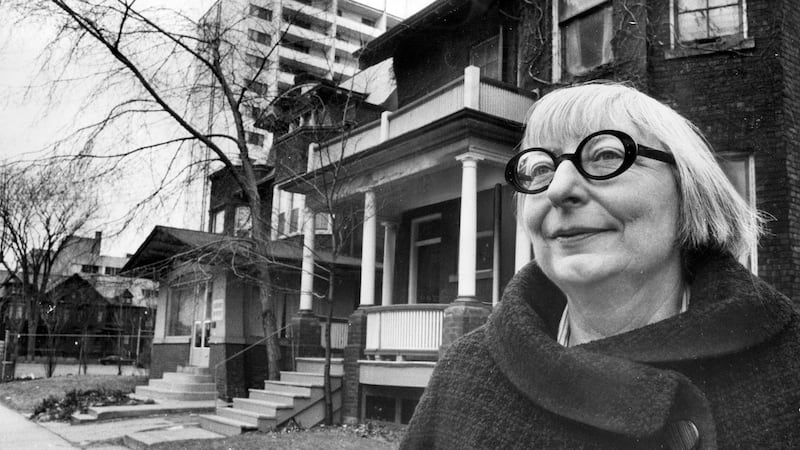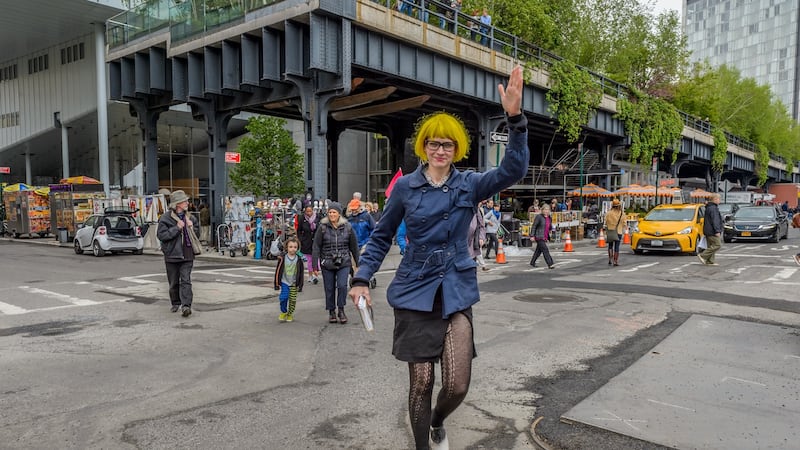This year cannot be allowed to pass by without reference to its being the centenary of Jane Jacobs, the renowned American thinker and writer on cities and urban spaces. Jacobs was an activist who emboldened many to challenge the established order when it came to public planning, someone who said of the metropolis: “There is no logic that can be superimposed on the city; people make it, and it is to them, not buildings, that we must fit our plans.”
We should hold on to her ideas: Jacobs was a common-sense champion of how places should be allowed to grow and shape themselves around us, not the other way around.
Down the years her work has been a source of elucidation for many people who have cared for the environment surrounding them, but who perhaps have been unsure about how to mobilise their thoughts against the abstraction of civil bureaucracy, something which often seeks to depersonalise – disengage us from – our living space.


Understandably a raft of books have appeared to coincide with the centenary of her birth. Becoming Jane Jacobs by Peter L Laurence (University of Pennsylvania Press), Jane Jacobs: The Last Interview and Other Conversations (Melville House Books) and Eyes on the Street: The Life of Jane Jacobs, the biography by Robert Kanigel (Knopf) look like notable additions to the canon.
However, it is a masterwork from her own pen for which Jacobs will be best remembered. The Death and Life of Great American Cities was first published in 1961 – a reprint is available from Vintage – after an article by Jacobs three years earlier in Fortune magazine was noticed by the Rockefeller Foundation, which offered her funding to write about cities.
High-rise towers
A postage-stamp synopsis of the book is that Jacobs felt cities to be organic, that they evolve and develop over time depending on how the people living in the space use it; cities would not be formed with some painting-by-colours methodology of planning.
The streets are what make the city, wrote Jacobs, which was contra-modernism and its fashionable Corbusien ideas at the time of neat grids and high-rise towers lifting people off the streets. These ideas would have resulted in a place where people are looking inwards at courtyards, rather than outwards to what Jacobs called the ballet of the daily workings of the street.
“Cities have the capability of providing something for everybody, only because, and only when, they are created by everybody,” said Jacobs, in her ardent opposition to one-size fits all planning. She wanted diversity, density and engagement and maintained that cities were safer with “eyes on the street”.
Jacobs was an autodidact and an outsider, just like that other great poet of place Ian Nairn. She was not some sleek metropolitan and The Death and Life of Great American Cities rocked the establishment and rattled architecture's gilded cage.
Quite an achievement for someone born in the unfashionable coal-mining town of Scranton, Pennsylvania in 1916, and who had no college education or formal training.
It is also worth bearing in mind the general attitudes to a strong-willed woman in that era; all these facts probably added to the shock felt by Jacobs's temerity; the New Yorker critic Lewis Mumford dismissed her reflections as naive while reviewing the book under the headline Mother Jacobs' Home Remedies, for example).
Born Butzner to a doctor father and school teacher mother, it seemed young Jane was something of a firebrand from early on: playing pranks at school, showing little concern for authority by secretly reading books during lessons and holding imaginary conversations with Thomas Jefferson or Benjamin Franklin (depending on who was lodging in her imagination at the time).
She chose an unpaid internship at the Scranton Tribune instead of going to college, before moving to join her sister in New York in 1934. She worked various jobs, all the while immersing herself in the big city, before her first writing opportunity came. It was an unglamorous one in a metal trades paper, but it got her started, leading to a series of commissions from Vogue magazine.
Supposedly her pieces about the city were earning Jacobs $40 a time, while she was on $12 a week working as a secretary. While hosting a party in her apartment in April 1944, she met her husband, Robert Jacobs, an architect, and they married in May. Jacobs said later in life that she only wrote books due to his encouragement.
The Jacobs made their home above a sweet shop in 555 Hudson Street, in Greenwich Village, which these days can attract as many fans of architecture as any modernist masterpiece. Here she watched the dance of the street at dawn and dusk and evolved her ideas on urban planning even further by taking a position at the Architectural Forum.
Citizen empowerment
The esteem bestowed on Jacobs after the publication of
The Death and Life of Great American Cities
saw her become involved in the protests against New York City planning chief Robert Moses’s proposals to build the Lower
Manhattan
expressway. This was to run through the heart of Greenwich Village and the very streets where
Bob Dylan
would scuff his shoes and polish his verse.
The tussle between Jacobs and Moses has already been well documented (there’s even an opera based on it) so there is no need to go into it here. But the victory and Jacobs’s organisation of like-minded citizens who fought to preserve the Village was the embodiment of citizen empowerment. It showed everyone else that planning was too important to be left to the planners.
The long-running dispute has become the stuff of legend, partly because “ordinary mom” Jacobs took the fight both on to the street and into the corridors of powers. Moses, who was one of the most powerful figures in the US at the time, won.
Many on the left saw her as an inspiration of how an organised community can take on capitalism and come out victorious. Of course, Moses’s haughty attitude to the public played a significant role in the project’s defeat as well: at a proposal hearing on the plans, he was quoted as saying: “There is nobody against this – nobody, nobody, nobody but a bunch of . . . a bunch of mothers!”
As time went on, and the proposed motorway’s momentum faded, one imagines Moses probably affixed another word to the merry band of “mothers”.
In the end those who fought to save Greenwich Village were triumphant, although the Jacobs moved on. They went to Canada in 1968 after their two sons said they would d rather go to jail than be conscripted to fight in Vietnam.
Unsurprisingly, Jane Jacobs soon became involved in similar campaigns in Toronto. She remained there until her death in 2006, aged 89.
Undesired change
The historian Robert Caro, who has written a tome on Moses, said she was not the first person to stress the importance of neighbourhood, which is correct, but he went on to add: “But no one had ever said it so brilliantly before. She gave voice to something that needed a voice.”
What Jacobs would make of what we call “gentrification” today is hard to say. She believed in cities growing by themselves, so would her theories apply to the tech generation that has taken over San Francisco, squeezing out the diversity and freakbeat fabric that made the city one of the most distinctive in the world? Or to Paris, which is now mostly an urban centre for the wealthy, ringfenced by poverty and the rest of the population?
Organic developments can also embody undesired change and urban cleansing; it would have been nice to have heard her views on such places.
Ultimately, Jacobs helped change the way we think about cities, whether you believe her ideas stand or fall. She gave us another prism through which to consider how we plan our urban space: when we do intervene, it shouldn’t be just about making things new, it should be about making things better.
One hundred years on from her birth, we now have the necessary perspective to realise how perceptive she was. Those “eyes on the street” she talked about included her own, always framed by those striking owlish glasses. We were lucky to have them.
















